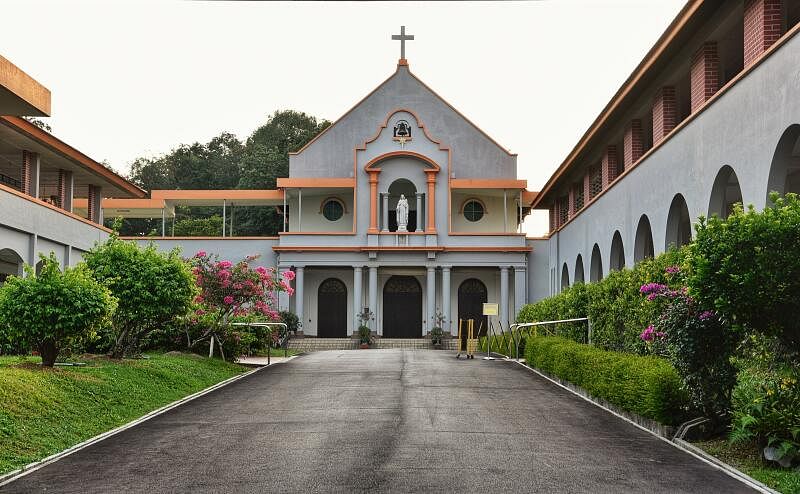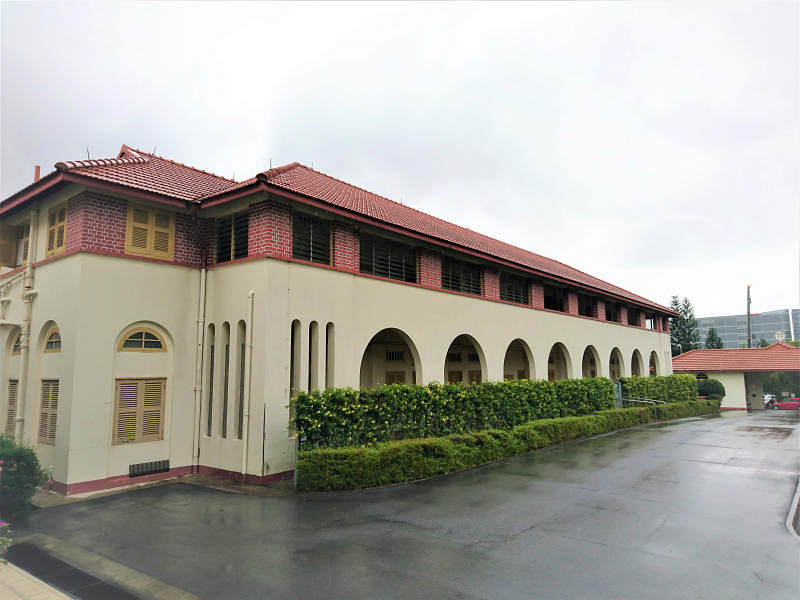SINGAPORE - A cluster of buildings in Upper Thomson Road that has served as a safe haven for the vulnerable for more than eight decades is set to be conserved.
On Friday (Oct 15), the Urban Redevelopment Authority (URA) announced its proposal to conserve six buildings and an entrance archway belonging to St Theresa's Home.
The structures, which include a chapel, dormitory blocks and an administration building, have stood since 1937 when the home moved to Upper Thomson from a small facility in Derbyshire Road that it had occupied since its inception in 1935.
A recognition of its architectural and social significance
URA said the move is in recognition of the buildings' historical, architectural and social significance, as well as their contribution to the sense of identity and character of the Upper Thomson area.
They were designed by pioneer architect Ho Kwong Yew, and serve as a rare and intact example of a pre-war purpose-built welfare home, said URA.
At its genesis, the home was known as the Little Sisters of the Poor Home for the Aged, named after the Little Sisters of the Poor, a Roman Catholic order of nuns that established it. The order continues to be one of the world's best-known charity organisations involved in helping the impoverished elderly.
It ran the home for 68 years, taking in the aged sick regardless of religion or ethnicity - against the norm during the colonial era.
What is being proposed for conservation
After the order left Singapore in 2003, the Catholic Welfare Services - the social service arm of the Catholic Church in Singapore - took over management of the home and renamed it St Theresa's Home.
Today, the markings of its old name can still be seen on the facade of the home's entrance archway and gate house, both of which have been proposed for conservation.
Look closely at this photo of the home's gate house and you can make out the old name peeking out from behind the new ones in blue.

And here's the same thing on its entrance arch.

Also part of the URA's proposal are five other buildings.
The first is a two-storey chapel that lies at the home's heart. The chapel has a reinforced concrete barrel vault ceiling, and its pulpit is in a semi-circular recess that is framed by an arch, giving it depth and focus that draws the eye of the worshippers.

On the chapel's second floor is a statue of the Virgin Mary, which overlooks the landscape garden. It is framed by an arched pediment and supported by classical style columns.

Two identical two-storey dormitory blocks, one seen in the photo below, which flank the chapel on either side, are also proposed for conservation. They have a distinctive first-storey arcade that rises to form the second-storey parapet, and are topped by a broad roof that hovers above the upper veranda.

The sisters' quarters and an administration building, located towards the front of the compound, round off the list in URA's proposal.
The two colonnaded buildings frame the view of the chapel from the landscape garden. The administration building, seen in the photo below, is on the right of those entering the compound.

The photo below shows the sisters' quarters which are across from the administration building.

Several other buildings in the compound were not included in the proposal. A URA spokesman said these buildings were built in the 1960s and 1970s and will be redeveloped as part of upcoming plans for the site. The cluster of buildings are highlighted in this map.
URA said its proposal is supported by the site's owner, the Titular Roman Catholic Archbishop of Singapore.
The site will be the first of the Catholic Church's properties that were used for social services to be conserved.
URA added that the owner has plans for adaptive reuse of the buildings that have been proposed for conservation, as part of its redevelopment plans for the site.
This will involve housing an archdiocesan heritage centre, church archives, church organisations' offices and a priests' retirement home in the conserved buildings, where feasible.
"(This) allows the site to cater to modern needs while safeguarding its rich heritage," said URA, adding that it will work closely with the owner to facilitate the conservation process, and guide it on meaningful uses of the heritage buildings.
A Catholic Church spokesman said the chapel will continue function as one, while it is still planning the specific uses for the other buildings that will be conserved. The entrance arch will be moved to an appropriate alternative location on site, he said.
The Catholic Foundation had previously announced its intentions to redevelop the plot of land occupied by St Theresa's Home to house the Catholic Hub - a centre for the archdiocese's activities.
The spokesman said the church started working on the proposed redevelopment about five years ago, and that the hub will bring various church organisations together for programmes and activities. Redevelopment works will begin in the second half of 2022 and will be done by end-2025.
The Catholic Welfare Services is planning to relocate St Theresa's Home to another site with more facilities and more beds. The new home will be ready around end-2026.

Conservation specialist Ho Weng Hin welcomed URA's move, saying the existence of such an intact site in prime land is unusual.
Mr Ho, who visited the site about a decade ago for a book project, described it as a time capsule that has retained its purpose and character since it was built. It was included in the book Our Modern Past, a compilation of Singapore's modern architectural works published by the Singapore Heritage Society.
He also praised the decision to conserve not just one building but several that were most significant, as these buildings accrue value in a group, and together tell the story of how the various structures served different purposes for the home.
Other such intact sites warrant a closer look and should be considered for conservation, he added, citing Old Changi Hospital as well as clusters of colonial-era bungalows and former barracks at Changi Point.
Also worth a look at are Paya Lebar Air Base and Turf City - sprawling sites that house structures of social significance and have been earmarked for redevelopment in future - said Mr Ho.
He added that the conservation would also recognise the Aw brothers Boon Haw and Boon Par - philanthropists whose donation made the home's building possible.
Another site that is yet to be conserved directly links St Theresa's architect Ho Kwong Yew and the Aw brothers: Ho had designed pavilions and a mansion for Haw Par Villa, which Boon Haw built for his brother in the 1930s.
"These sprawling sites and developments are a reminder that the community then was not just run by European elite, there were also non-Europeans like Ho and the Aw brothers who made significant lasting contributions to society," said Mr Ho Weng Hin.
The proposal to conserve the six buildings and the entrance archway was published on Friday and will be open for public feedback and comments until Nov 13.


